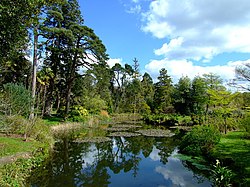Fota House
| Fota House | |
| County Cork | |
|---|---|
 Fota House | |
| Location | |
| Grid reference: | W79167128 |
| Location: | 51°53’37"N, 8°18’13"W |
| History | |
| By: | Sir Richard Morrison and Vetruvius Morrison |
| Country house | |
| Information | |
| Owned by: | Irish Heritage Trust |
Fota House is a grand, Regency-style country house on Fota Island in Cork Harbour, in County Cork.
This was the former home of the Smith-Barry family (Earls of Barrymore since 1627), descendants of Philip de Barry. The de Barry family came from Glamorgan as part of the Norman invasion of Ireland. The family were granted lands at Fota and elsewhere in 1185. The family first resided at Barryscourt Castle, Carrigtwohill, then at Castlelyons where they held extensive lands.
Fota House was originally a hunting lodge and became the family's main residence in the 1820s when the architect, Sir Richard Morrison (1767–1849) and his son Vetruvius Morrison (1794–1838),[1] created the present regency mansion with over 70 rooms.
The last member of the Smith-Barry family to live in Fota House was Dorothy Bell (1894–1975), daughter of Arthur Smith-Barry, 1st Baron Barrymore (1843–1925). She continued to develop and record the plant collections in the gardens and in the arboretum, which her family had started in the 1840s. On Bell's death in 1975, the estate was sold to University College, Cork.
During the latter part of the twentieth century, the house fell into some disrepair – culminating in the collapse of a ceiling. This closed the house to the public for some time. It was restored using taxpayers' money and private funding, reopening in early 2002. In December 2007, the new Irish Heritage Trust took over responsibility for Fota House.
Fota Gardens

Fota Gardens are in the grounds of Fota House. These consist of a structured arboretum, walled garden and terraces. The gardens include rare and exotic shrubs and trees, along with an extensive rose garden.
The layout and structure of the arboretum and gardens date largely from the tenure of the Smith-Barry family, who recognised the significance of Fota's sheltered location and warm soil — "Fota" is derived from the Irish "Fód te" meaning warm soil. The conditions are appropriate for the growing and cultivation of certain trees and exotic plants.
The development of the arboretum and gardens coincided with the great plant hunting expeditions around the world bringing back specimens from places such as Asia, South America and the Pacific coast of northwest America. Some of these rare plants found their way to Fota within a few years of their discovery.
In the 1840s, John Smith-Barry ensured that trees were well-spaced - enabling them to thrive with displays of seasonal colour. The family also recorded the plant collections throughout the 19th and most of the 20th century and this work of cataloguing, conservation and development continues today.
Many of these plant collections are arranged in association with the National Botanic Gardens in Glasnevin, Dublin, and other botanic institutions such as the Royal Botanic Gardens Edinburgh.
In 1996 the Irish state was given control of the arboretum and gardens. They are now administered by the Office of Public Works in conjunction with the Irish Heritage Trust.
Outside links
References
- ↑ Leland, Mary,Let's do all we can to make sure it's not a Fota finish, Independent.ie, 27 June 2004.